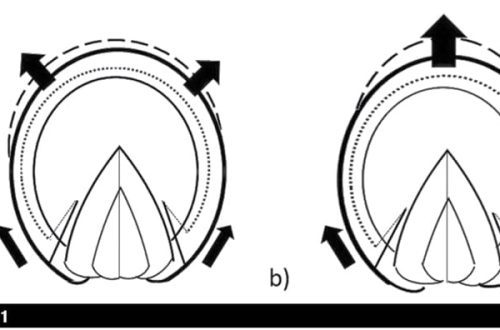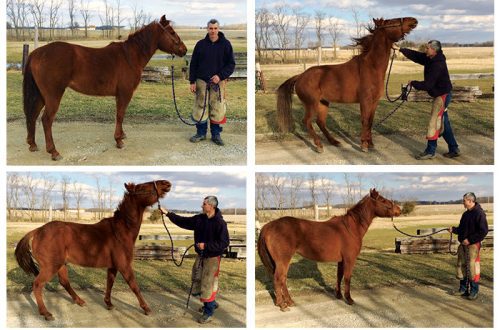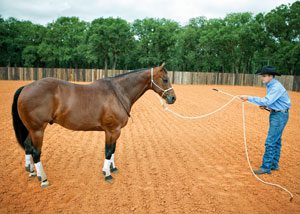
Clinton Anderson – Earn your horse’s respect
Clinton Anderson – Earn your horse’s respect
A horse’s respect cannot be achieved “automatically”; it does not come from nowhere. It must be earned. The best way to do this is to use the same tactics that horses use to gain respect from each other.
“You earn respect from a horse by moving its legs forward, backward, left and right, and always rewarding its slightest attempt to answer correctly,” says Clinton Anderson, a trainer who needs no introduction.
“When horses go out to pasture together, they begin to establish a hierarchical order. At first, a tense situation will remain in the herd, fights will take place. But within a few days, a hierarchical order will be built up, and only one horse – most often the oldest mare – will be the leader of the herd. But how did she gain control of the group? She proved to all the horses in the pasture that she could make them move forward, backward, left and right.”
Hierarchical order
Horses communicate through body language. Sometimes they squeal, snort, neigh and goog, but most of their messages are silent. The mare (future leader) relies on a systematic step-by-step approach to get other horses to move and therefore respect her.
If another horse was standing by a pond, and this mare wanted to make her leave, she would act according to the plan. First of all, she would plug her ears. If she had been ignored, she would have bared her teeth and pretended to want to bite the second horse. After that, she might have tried to bite for real. If the horse had not moved away, the mare would have turned around and started waving her tail, pretending to strike. Then she would hit for real and keep hitting until the second horse was gone. The one who gives in first loses the fight. All these steps take only a few seconds.
“Despite the fact that the boss mare showed several stages of pressure, she did not linger on any of them for too long,” Anderson emphasizes. She didn’t bare her teeth for five minutes before trying to bite. But she gave the second horse a chance to move at each level of pressure, and if she didn’t get the response she expected, she increased the pressure.
Horses are constantly fighting for a position in the hierarchy, trying to rise to a place above. They test the leader every day, and the boss mare will have to prove to them that she can still get them to move their legs.”
The same will happen in your relationship with the horse. The key to success is that you must be worthy to play the role of leader.
“Horses challenge other horses in the herd every day, and they will do the same to you,” Anderson says. – Nothing personal; it’s just business. Horses are naturally willing to follow and be led, but they need a leader they can respect and trust.”
The number 1 horse in the herd does not have to be the largest or strongest; she just has to be the bravest and smartest. She must be the most effective leader. When she tells the other horses to move, they had better move, or she will back up the request with an action. Keep this in mind every time you work with a horse. The more you can get the horse to move, the more control you have, and vice versa. The reverse is also true: the more your horse makes you move, the more disrespectful he will be towards you.
Gaining Respect
Respect is essential because it opens the door to trust and creates a safe, mutually beneficial partnership between you and your horse.
“Respect has to be established from day one with a horse,” Anderson says. She must respect you, and you must respect her. This is a two-way street. Respect is the basis of control; without it, you will not be able to control your horse and he will be miserable at work. Unfortunately, respect cannot be conveyed with a horse,” Anderson continues. This means that you can buy a well-trained horse, but if you do not establish a respectful partnership with him, he will not work well with you for a long time. Just because I have earned the respect of the horse, I cannot pass it on to you – the horse will not respect you and me equally. Each individual is responsible for earning the respect of each horse.”
While conducting seminars and trainings around the country, Anderson found that many people get frustrated because after spending a lot of money on a well-trained horse, after just six months, they find that the horse starts acting like it knows nothing and can not.
“If I sold you one of my well-trained horses and you took her home and didn’t earn her respect, set yourself up as a leader and make her legs move forward, backward, left and right, she would turn from a safe, obedient partner into a disrespectful thug who would force you to move,” Clinton says. – In order for the horse to continue to use the thinking side of his brain and remain respectful, you must constantly remind him how to use it, making him move forward, backward, left and right, and always rewarding the slightest attempt at the right answer. Horses never stay the same. Every day they either get better or a little worse. However, if you maintain this respect and increase it, your horse’s behavior will only get better.”
Leader or friend?
Naturally, you want to be friends with your horse, but it’s really more important to be a leader for your horse. If you only treat your horse as a buddy, he will tend to disrespect you. Some people mistakenly believe that their horses will respect them as soon as they know they are loved, but this is not true – the horse’s brain does not work that way.
“If you just love your horse, care for and feed him, and never ask to leave your personal space, he will never believe that you deserve to be her leader,” says Anderson. – The more attention you pay to your horse, care for it, feed it without asking for anything in return, the more dominant it will become in relation to you. A horse that doesn’t respect you eventually decides it’s in control. But you can’t just be friends with a 500 kg animal like a puppy, because such friendship without respect is dangerous. Many situations – riding in unfamiliar terrain, jumping over an obstacle – can only be safe if the horse respects you as a leader. I’m not saying that you can’t give a horse a treat or that you can’t love it. Of course you can and you should. Both of these methods are a great way to reinforce the correct answer. Just remember that pleasure is a bonus. These are not bribes.”
Your attempts to become a good leader will be much more successful if you understand how the horse’s brain works and how it reacts to different situations. Without this knowledge, you will only fight.
“Riding isn’t always easy, but it will be easier when you can identify what motivates your horse to act the way he does,” says Anderson. “When you first introduce a new skill, the horse will be a little confused, confused, possibly nervous and flustered. This is absolutely normal. Horses are allowed to express all of these emotions during training. Your job as a trainer is to learn how to help your horse understand what you expect from him in the easiest way.”
Respect step by step
Horses learn better if we use step-by-step methods. “They are intelligent creatures, but they are not able to process too many diverse information at the same time,” Clinton explains. “I once realized that if I take the time to break the lesson into steps/parts and start introducing the horse to each step individually, he will understand the lesson much faster and will progress faster.”
Anderson regularly uses his Knock the Air exercise and considers it a leading tool. The goal is that when you tap the air in front of your horse, he should respond by moving away vigorously, showing respect.
“The better you can rein in the horse, the more respectful and responsive it will be in any situation,” says Anderson. – Good reining is the basis of stopping, as well as collecting. A horse that respects you will rein back any time you ask it to. If the horse does not respect you, ignores you – this is fraught with the manifestation of dominance in the future. If you don’t rein back your horse, he will show you more and more disrespect.”
Air tapping exercise
Clinton Anderson uses this exercise to teach a horse to back off respectfully when asked.
Do the following:
1. Take the cord and tie it around the horse’s neck. Wrap some duct tape around your lead at a distance of 1,20 from the carabiner (the length of your whip). This is the initial safe distance when teaching the horse to rein back. The duct tape will be a reference point – so you can remind yourself where, while working on this exercise, you should keep your hand on the lead,
2. Hold the lead by the place wrapped with electrical tape in one hand, take the whip in the other. Hold your hand like you would for a handshake. Stand right in front of your horse and make sure he has two eyes on you. She cannot fully turn her attention to you if she does not look at you with both eyes. If he turns away, send waves along the lead so that the halter disturbs him until the horse focuses on you again.
3. Tap the whip gently and rhythmically in the air in front of your horse’s nose. Count out loud: “One, two, three, four.” If she doesn’t respond, tap the whip gently on the lead—one, two, three, four. If the horse does not back off from this pressure, tap harder. If she still ignores you, hold the whip horizontally and tap the lead four times. If she still doesn’t respond, tap her on the nose.
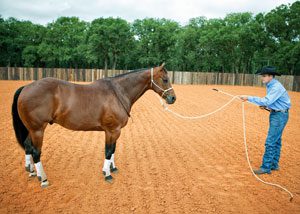
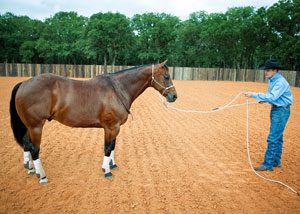
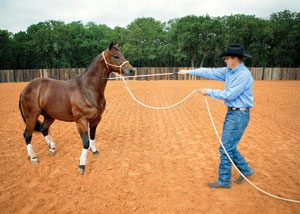
“Your horse’s sensitivity level and how much respect he has for you has a strong effect on the amount of pressure you apply,” Anderson says. A sensitive horse doesn’t need much pressure. A lazy and disrespectful horse will need more pressure. Increase the pressure level until you get the desired response. Remember, do what you need to do to get the job done. Simplify as much as possible, but be adequately assertive.”
4. As soon as your horse takes two steps back, take the pressure off and rub between the eyes with the whip. You’re just looking for a starting point to teach her that when you apply pressure in front of her nose, she needs to back away from it. It is very important to rub her with the whip between her eyes so that your tools do not bother her; the goal is respect without fear. Be careful not to require too many steps in the beginning. Get two steps and then reward the horse, two more steps, more reward.
5. Once your horse can consistently take two steps back, ask for four consecutive steps. At first, she may throw her head up. When a horse is stuck in place, it raises its head. If her legs are energetic, her head goes down. Don’t worry about the horse’s head; focus on moving her legs. Once they do, the head will drop on its own.
6. Once your horse understands the concept of the exercise, expect him to give more energy. Keep increasing the pressure until she does. Relieve pressure as legs move light and energetic. Don’t stop or let the horse stop if he’s stepping heavily and struggling with the pressure. Horses don’t learn through pressure; they learn when you take it off. No matter what the horse does when the pressure is released, you are rewarding him for that action.
7. Every day, ask your horse to take more steps back with increased energy. By the end of the first week, with consistent practice, she will be able to take 15 to 20 steps.
Cynthia McFarland (source); translation Valeria Smirnova.



